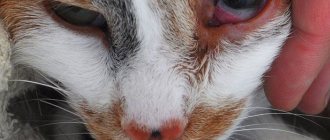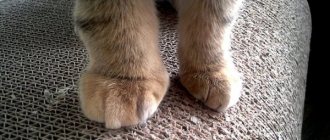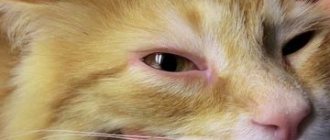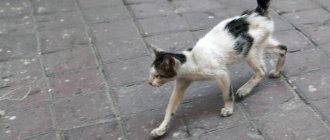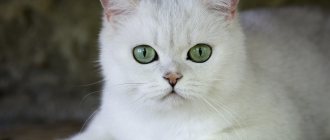If your cat has a swollen cheek under the eye for unknown reasons, and the swelling hurts when you press it, it is better not to wait for the situation to resolve on its own, but to take your four-legged friend to the veterinary clinic as soon as possible. There are various dental and other pathologies in which a neoplasm appears on the inside or outside, filled with pus or other pathological exudate. Therefore, in order for the treatment to be correct, it is important to find out an accurate diagnosis.
Main reasons: what could be a provocateur?
A bump on a cat's cheek can be caused by an insect bite, such as a bee or wasp. In this case, the tumor is localized on one side, the animal’s eye waters, and the swelling spreads behind the ears and on the neck. If the formation appears on the outside, it is inflamed and festers, it looks like the cat has acne, which, like in humans, is a consequence of some pathological internal disorders.
Often cats have swollen cheeks for the following reasons:
- Flux. Dental disease caused by insufficient oral hygiene, jaw injuries, various diseases of the gums and teeth.
- Abscess. It is often a consequence of an advanced infectious-inflammatory process localized on the facial part. The cavity of the formation is filled with pus, and the cat’s cheek is swollen so that even the eye is swollen. If nothing is done and the pathology is not treated, the infection spreads and necrosis of the affected tissues occurs.
- Hematoma. Occurs after injuries, blows, bruises. The hematoma cavity is filled with dried blood, often the formation looks like black tubercles.
- Muscle inflammation. It occurs against the background of a progressive viral infectious disease, helminthiasis, hypothermia, and metabolic disorders.
- Neoplasm of malignant nature. With this disease, it becomes noticeable that the animal’s right or left side of its muzzle is swollen. The formation quickly increases in size, does not heal, constantly bleeds and festers, and when pressed it causes pain in the pet.
What can cause a cat's cheek to swell?
The listed diseases have their own causes, clinical symptoms, methods of diagnosis, treatment and prevention, so a separate subsection is devoted to the description of each.
Abscess
The abscess has broken through
An abscess is a cavity that appears as a result of purulent melting of tissue. There are combat and dental ulcers.
Combat develops when an infection occurs during a fight. Not only the claws of cats conflicting over territory or females. The pet gets it from dogs or rodents. The infection enters the cheek with a splinter, or first injury occurs with sharp or prickly objects. Males are predisposed to fighting abscesses, since females are less likely to conflict with each other.
A swelling appears on the pet's cheek, which the owner notices when it has already formed. Most often, the abscess breaks out on its own during another fight and the owner notices a wound from which pus has already flowed out. The skin defect closes and scars without any treatment, or the owner applies an antiseptic spray or ointment.
Dental abscess most often develops in pampered pets when they eat soft, wet food that sticks to the gums. First, plaque forms from food debris and multiplied bacteria - permanent inhabitants of the mouth cavity. Calcium salts fall from saliva onto the surface of plaque. The mass hardens and tartar (dentolite) forms. The next stages of pathogenesis are gingivitis, caries, periodontal disease.
Be sure to read:
What to do if a cat has a lump on its ear?
Anaerobic conditions arise under the stone and suppuration develops, which resembles gumboil in humans. In addition to the fact that the cheek swells, the mouth smells unpleasant. The pet is depressed and refuses to eat. If the disease is not treated, the infection penetrates the internal organs and leads to the death of the cat.
After surgical opening of the abscess, surgical removal of tartar using ultrasound may be necessary.
It is impossible to prevent combat abscesses. Even castrati are not immune from being beaten by street cats.
Prevention of dental abscess involves using food of at least premium class, which includes specially structured dietary fiber that removes plaque from the gums.
If the owner notices the plaque too late and it has hardened, the problem is corrected by using veterinary food that contains an increased amount of structured fiber.
Veterinary nutrition for the treatment of tartar
The use of medicated food allows you not only to clean your teeth, but also prevents the development of urolithiasis, and also prevents obesity.
What should natural nutritionists do? Accustom your pet to brushing its teeth from kitten age. You cannot use paste intended for humans, otherwise the cat will resist subsequent procedures.
Acne
Acne, initial stage
First, comedones appear on the chin - blackheads. The reason is blockage of the sebaceous glands. The disease develops where food or water bowls are not washed. The occurrence of the disease is facilitated by stressful situations, as well as treating pets with human delicacies and table scraps.
With timely treatment, the process ends with the elimination of acne on the chin using external means. However, in advanced cases, the sebaceous glands on the face and other parts of the body become inflamed. Boils form.
The disease follows the same scenario as a combat abscess, however, it is characterized by a longer duration. If external remedies do not help, seek veterinary help. Anti-inflammatory corticosteroids and antimicrobial drugs - cephalosporins or amoxicillin derivatives - are prescribed.
Be sure to read:
A cat's teeth are falling out: physiological and pathological reasons, what to do, prevention
Prevention involves regularly washing food and drinking bowls, stopping giving table scraps, and avoiding stressful situations.
Allergic reaction
A hypersensitive reaction to irritants is accompanied by swelling, as well as skin rashes, sneezing, coughing, shortness of breath, vomiting, diarrhea, and itching.
Stung by a bee
The cheeks and areas under the eyes swell under the influence of the following unfavorable factors:
- Insect bites: If a cat is stung by a bee, the bite site will immediately swell. The reaction to flea bites develops slowly. In some cases, the swelling disappears spontaneously. The treatment is carried out by the cat's owner. The pet is calmed and given Suprastin or another antihistamine. The owner of an allergic cat must have an ampoule of Dexamethasone with him and know how to use it, since individuals predisposed to the disease may develop anaphylactic shock.
- Anaphylaxis - develops in cats that are sensitive to vaccines or serums. If biological products are administered for the first time, you must wait and not leave the clinic for 15-20 minutes. A veterinarian will provide assistance. No less dangerous is repeated administration of the drug, to which the pet may react violently. If it turns out that the cat has a hypersensitive reaction to biological products, the veterinarian is informed about this, and he administers antihistamines before the procedure. At the request of the animal owner, a specialist will explain how to use Dexamethasone.
- Allergies to food and external irritants: occurs to dietary components, tobacco smoke, pollen, household chemicals, perfumes, accessories, toilet fillers, certain medications, flea products. In addition to swelling, conjunctivitis, skin rashes, and itching occur. To eliminate food allergies, use ready-made hypoallergenic food. Swelling that occurs in response to external irritants is relieved with antihistamines prescribed by a veterinarian.
Malignant neoplasm
A swelling on the cheek may be the result of a malignant tumor in the pet's mouth and cheek. Older cats most often develop fibrosarcoma or squamous cell carcinoma. Additional symptoms include drooling, bleeding, refusal of solid food, and bad breath. The cause of the disease is determined on the basis of a clinical examination, anamnesis, general blood test, x-ray, ultrasound, and histological examination.
Be sure to read:
What causes growths on the pads of cats front or back paws?
The veterinarian prescribes surgical treatment, chemotherapy, and radiation. The prognosis ranges from doubtful to unfavorable.
Symptoms that require immediate medical attention
With such a pathology, the animal may lose interest in everything.
If your pet has been bitten by insects or a dangerous internal disease develops in the body, under the influence of which the cheek is swollen and the muzzle is swollen, in addition to the presence of a neoplasm, the following signs will be present:
- redness of the affected area;
- inflammation, local increase in temperature;
- loss of appetite;
- rapid weight loss;
- bad breath;
- swollen lymph nodes;
- excessive salivation;
- severe pain on palpation;
- lethargy, drowsiness, apathy.
How does the disease develop?
After injury, blood vessels rupture. The bloodstream of the periosteum itself is also damaged, and serous and serous-fibrous exudate is exuded. As a result, we see a typical inflammatory reaction. The process starts with the inner layers and extends throughout. Resorption of the lesion will occur if the damaging factor is eliminated in time. If damage to the periosteum continues, more vessels rupture, a significant amount of fibrinogen effusions, and cellular elements leak into the surrounding tissues and periosteum. These elements permeate the fibrous layer of the periosteum, its cells intensively grow into the affected areas of tissue. So aseptic periostitis develops into fibrous, and then into ossifying.
Clinical signs
All inflammatory processes of the periosteum are accompanied by the appearance of swelling. It is poorly limited; when palpated, a sharp pain occurs, since many nerve fibers pass through these places. Locally, an increase in temperature can be noted. An animal limps if its limbs are affected (weight-bearing lameness). There is usually no general response to this type of inflammation other than a slight increase in temperature in horses.
Treatment methods
The pet is treated according to the general rules of aseptic inflammation. First of all, it is necessary to ensure rest for 1-2 weeks. Aseptic inflammation lasts much longer than bruises, sometimes more than 20 days.
If the exposure to the factor is prolonged, the inflammation threatens to develop into purulent or ossifying inflammation. If a purulent course is established, then surgical treatment is indicated.
How to treat?
At the first stage, agents are used that reduce the exudation process. This includes local cold, application of a pressure bandage, short novocaine blockades, as well as the prescription of anti-inflammatory drugs such as indomethacin, brufen, voltaren.
A good effect is observed when using the superposition of ring magnets, that is, the formation of a magnetic field.
At further stages, thermal physiotherapeutic procedures are indicated for accelerated resorption of exudate and restoration of damaged areas.
Diagnostics
To choose an effective treatment regimen, it is important to determine an accurate diagnosis and find out why the cat has a swollen cheek. During the initial examination, the doctor will try to determine the nature and nature of the tumor. To confirm the diagnosis, the following diagnostic testing methods are additionally prescribed:
With these symptoms, the animal is prescribed a urine test.
- general clinical analysis of blood and urine;
- biochemistry;
- microbiological examination of the contents of the neoplasm;
- X-ray of the jaw.
What treatment is prescribed?
If a kitten or adult cat has a swollen cheek due to an insect bite, then first of all you should find and pull out the sting, then apply a cold compress near the bite site. Sometimes an animal develops an allergy to the poison, which then causes symptoms such as suffocation, increased body temperature, weakness, and lethargy. If the veterinary clinic is far away, the cat should be given an antihistamine injection on its own and then taken to the hospital.
When an abscess forms, the cavity must be cleaned of pus, after which the wound is washed, and a course of antibiotics is prescribed to destroy the bacterial infection. You cannot do without antibacterial drugs for gumboil and inflammatory dental diseases. Sometimes the veterinarian will advise removing the diseased teeth or cutting the gum and clearing it of pus.
After the tumor is removed, the animal is treated with chemicals.
For muscle inflammation, a course of non-steroidal anti-inflammatory drugs and glucocorticosteroids is prescribed. Additionally, painkillers and warm compresses can be used. If there is a malignant neoplasm, the doctor will prescribe surgery, after which a course of chemotherapy and rehabilitation will be prescribed. Hematoma often does not require special treatment. Over time, the formation will disappear on its own; it is only important to ensure that it does not become inflamed.
To support the cat’s immunity during the therapy period, the doctor prescribes vitamins and mineral complexes.
What to do for prevention?
There are no special preventive measures to prevent the formation of a bump on a cat’s face. It is important to constantly monitor the health of the animal’s oral cavity, promptly treat caries, and pull out teeth that cannot be restored. In addition, it is important to prevent injuries and bruises to the pet’s face and not to let the cat become hypothermic. If there are viral infectious diseases, begin to treat the cat immediately under the strict supervision of a doctor. If your cat's cheek is swollen due to cancer, you need to determine an accurate diagnosis as soon as possible and begin treatment. If the owner discovers suspicious growths on a cat’s cheek, it is better not to ignore the symptoms, but to urgently show his four-legged friend to the veterinarian, because in the initial stages it is much easier and faster to get rid of the disease.
Treatment of a purulent abscess in a cat at home
Having established a diagnosis based on the listed symptoms, the animal must be shown to a doctor. A cat having an abscess in the mouth or on the body is a common occurrence. The veterinarian will easily diagnose and choose treatment tactics. Often the abscess has to be cut and opened to drain the contents. The clinic can perform this operation under general or local anesthesia, depending on the stage of the process and the condition of the furry patient. Hairless cats are less likely to develop abscesses - this is not a paradox, but a result of living conditions. They usually don’t walk on rooftops and don’t have to fight with their relatives. And the owners take care of their teeth and know the characteristics of the breed.
In most cases, antibiotics are prescribed; sulfa drugs help heal and eliminate unpleasant symptoms. The antibiotic is given for at least five days, often seven. Treatment cannot be interrupted, even if the mustachioed patient already looks healthy. If you stop taking it earlier, microbial resistance to this drug will develop. Then next time it will be useless.
No two situations are the same; you and your pet may be far from the cat doctor. And help is necessary. An abscess in a cat is a serious condition; treat it. Have patience, courage, draw up an algorithm of actions. Be your pet's savior yourself. Circumstances will “ask” you to become a surgeon for a while.
How to treat a cat's abscess yourself at home? Let's look at this step by step.
- Determine the stage of the disease. The initial stage is treated with heating - warm compresses and a heating pad will accelerate the maturation of the abscess. If the cat is very depressed due to pain, then you can give it an injection of novocaine, even a circumferential blockade (several injections of novocaine) to relieve pain. But keep in mind that if your cat has an elevated temperature and/or a significant tumor has formed in the sore spot, heat is contraindicated.
- An advanced disease requires surgical intervention; the accumulated masses need a way out. Prepare a sterile needle if the accumulation of exudate (abscess contents) is small and the puncture will be sufficient to drain this mass. If a cut is necessary, a razor blade sterilized in alcohol or hydrogen peroxide will do. There is a scalpel - even better.
- Wear sterile gloves. You will also need gauze (preferably ironed or sterile) wipes and hydrogen peroxide. You can use a solution of potassium permanganate, alcohol. Antibiotics will also be needed (solutions or ointments).
- It's good if you have help. He will hold the cat's paws during the procedure. It is not easy to make cuts or punctures on the head, but if necessary, you will have to. A purulent abscess that happened to a cat is no joke. If there is no one to help, then think about how best to keep your pet.
- First - pain relief. Novocaine, lidocaine - choose from the available means. A prudent animal owner has a first aid kit for them in case of emergency. Two or three injections around the abscess will help the cat undergo the operation more easily. Wait about ten minutes, the medicine will begin to work.
- Now it's up to you to act. Don't be afraid - this is a good thing. Now the cat is definitely not grateful to you, bear with both of you, you are saving the life of a little friend. How best to restrain a cat depends on the location of the tumor.
- If an abscess occurs on the cat’s neck, then after treatment it is advisable to put a special collar on the victim. It is made in the form of a cone, put on with the wide end forward. This will protect against subsequent scratching of the cut or puncture.
- Treatment of an abscess after freeing the cat’s cavity from exudate at home is no longer difficult. Cleaning the incision with antibiotics and dressings.
- Monitor the wound; it should not heal until the purulent contents cease to separate. The bandage is applied loosely, as air circulation is needed. Keep an eye on this; if it fits too tightly, it will disrupt the outflow and increase inflammation.
With normal healing, treatment for an abscess in cats lasts one week or a maximum of two weeks (when the incision is large).


